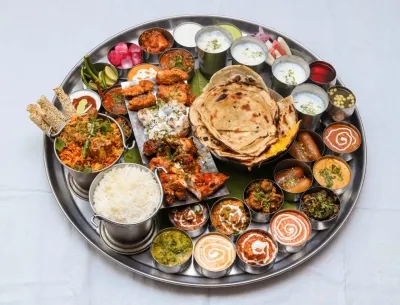Have Home-Cooked Veg and Non-Veg Thalis Become More Affordable?

Synopsis
Key Takeaways
- Vegetarian thalis decreased by 8 percent year-on-year in June.
- Non-vegetarian thalis saw a 6 percent decline in cost.
- Tomato prices fell significantly, contributing to the overall decrease.
- Future price increases are expected due to seasonal changes.
- Understanding the cost dynamics can help consumers manage their budgets better.
New Delhi, July 8 (NationPress) The prices of home-cooked vegetarian and non-vegetarian thalis saw a decrease of 8 percent and 6 percent (year-on-year) respectively, according to a report released on Tuesday.
The reduction in the cost of vegetarian thalis year-on-year was attributed to a significant drop in vegetable prices stemming from a high base, as highlighted in the Crisil Intelligence report.
“The price of both vegetarian and non-vegetarian thalis fell year-on-year in June, influenced by the weakening of vegetable prices. Specifically, tomato prices experienced a notable year-on-year drop,” stated Pushan Sharma, Director of Crisil Intelligence.
Looking ahead, however, “we anticipate a gradual increase in thali prices as seasonal shifts drive up vegetable prices. Onion prices are predicted to rise moderately due to limited fresh arrivals and regulated release of stored rabi stock,” Sharma explained.
For tomatoes, weak summer sowing is expected to contribute to a sequential price increase, adding further pressure on thali costs.
Tomato prices decreased by 24 percent year-on-year, reaching Rs 32 per kg in June compared to Rs 42 per kg in June 2024, influenced by a high base effect related to last year’s lower yields.
The prices of potatoes and onions also fell by 20 percent and 27 percent year-on-year, respectively, due to a high base.
Along with reduced vegetable prices, an estimated 3 percent year-on-year decline in broiler prices—which constitute about 50 percent of a non-vegetarian thali’s cost—contributed to the lower cost of a non-vegetarian thali, the report noted.
On a month-to-month basis, the prices of both vegetarian and non-vegetarian thalis rose by 3 percent and 4 percent respectively in June 2025.
The average cost of preparing a thali at home is determined based on prevailing input prices across north, south, east, and west India. The monthly variations reflect the financial impact on the average consumer.










